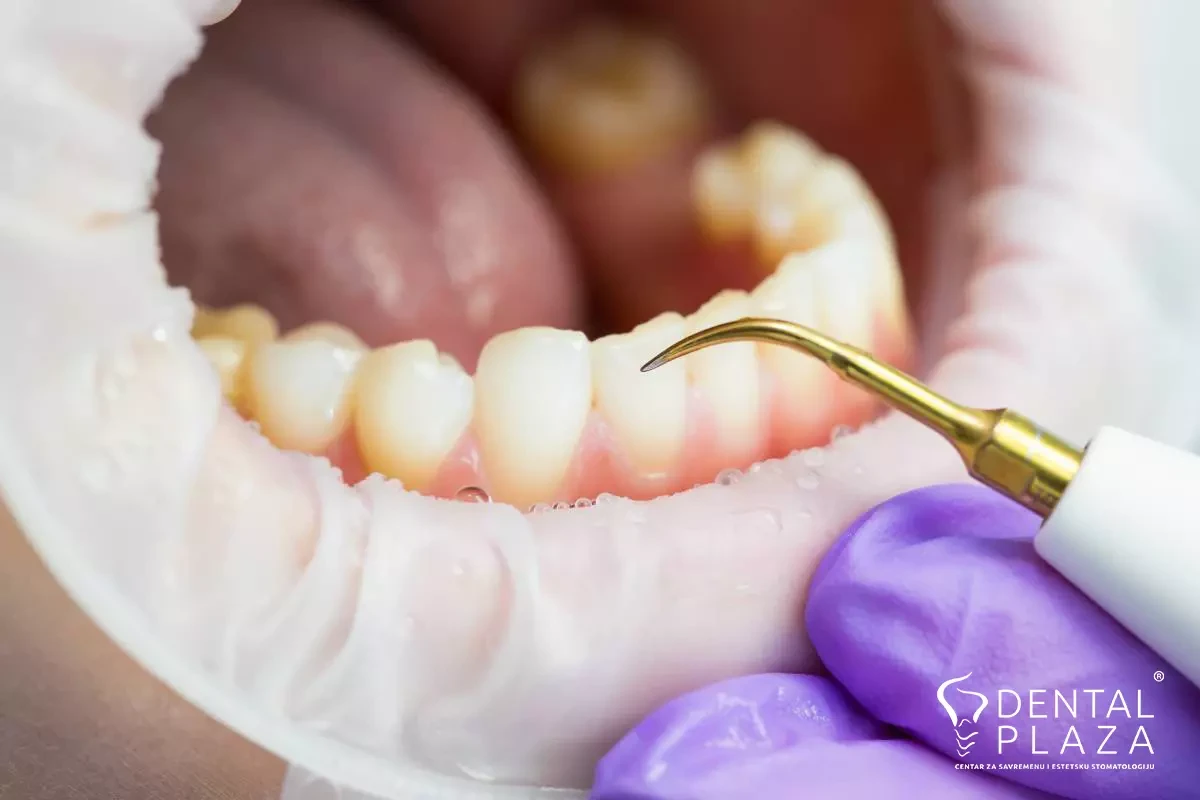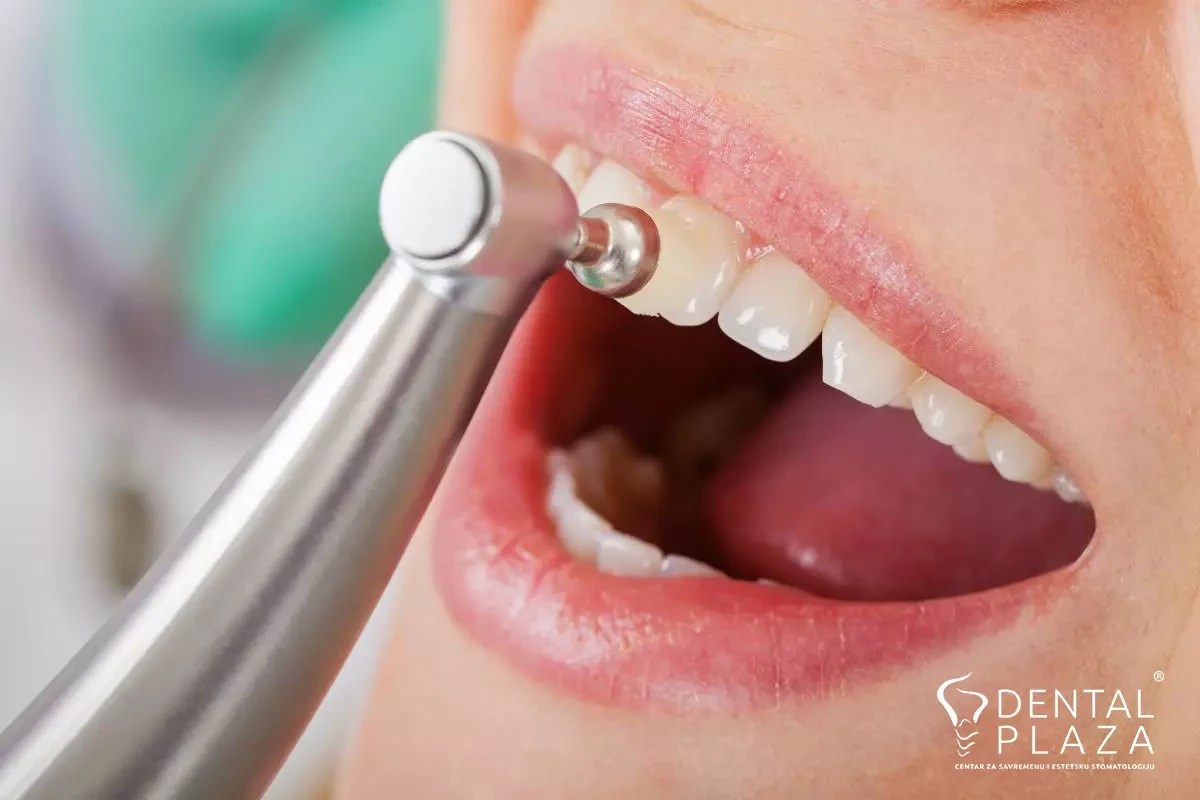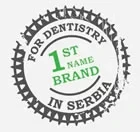Do not be shy, show your teeth!
Call Center 08-21h
Do not be shy, show your teeth!
Call Center 08-21h

Tartar represents solid, i.e. mineralized deposits of dental plaque and is formed by the deposition of mineral salts in dental plaque. The minerals in tartar mostly come from saliva. Most often, tartar is observed along the gums on the inner surfaces of the lower front teeth. The reason for this is that the sublingual salivary glands are located there.
Tartar deposited on the teeth is yellowish in color, and over time it can darken further due to the consumption of cigarettes and under the influence of discolored food. Tartar forming can be prevented by good oral hygiene. By regularly brushing the teeth, soft deposits, including plaque, are removed from tooth enamel, which prevents their deposition, and subsequently their calcification.
The speed of tartar formation depends on:
The consequences of tartar deposition on the teeth can be very complex, although they are often overlooked even by dentists. Namely, it has long been known that tartar is the main initial cause of periodontopathy. Periodontopathy is a progressive, degenerative disease of the periodontium (the supporting apparatus of the teeth), which, over time, can lead to wobble, displacement and loss of teeth. Along with caries, it is the most widespread disease of the dento-facial region.
Accumulated on the teeth, tartar exerts mechanical pressure on the gums (gingiva) and makes further oral hygiene more difficult, and as a result, swelling of the gums, bleeding, sensitivity of the gums, and then their withdrawal, resulting in the exposure of the tooth necks, can occur. This process is slow and long-lasting, but it is also unstoppable, and exactly this slow development and lack of clear symptoms often misleads the patient, who decides to take action only when it is too late, i.e. when periodontopathy has already developed in its full form.
The therapy of periodontopathy is a painstaking process that requires a lot of time, effort and discipline of the patient, where a full cure very often cannot even be achieved, but even just stopping or slowing down the progression of the disease is considered a success. On the other hand, tartar removal is a simple and painless procedure that requires only one visit to the dentist. From this, one can easily conclude the importance of good oral hygiene, removal of tartar and regular check-ups at the dentist. Apart from the health significance, there is also an aesthetic effect. Teeth look much healthier and whiter if there are no tartar deposits on them, which is especially pronounced in smokers, because the rough surface of the tartar is an ideal substrate for nicotine pigment.
Tartar is most often removed exclusively in the dental clinic by using ultrasonic instruments, specially made for that purpose. If sometimes access to these instruments is not possible, then manual instruments designed for that can be used. Ultrasonic removal of concrements and of pigmentation is a completely painless method and is based on the fact that the tiny vibrations created by the device are transmitted through an extension, together with water, to the instrument used to remove the calculus. They turn into small mechanical impacts that can remove all the deposits from the teeth. After this, it is necessary to polish the teeth with a highly abrasive paste and a rotating brush.
This procedure is usually painless. However, there are some situations in which the use of this device is contraindicated, such as in patients with an implanted pacemaker. It generally does not require the use of anesthesia, because mild sensitivity can only occur in the area of the neck of the teeth and lasts for a short time - as long as the intervention itself.

It is recommended to remove dental tartar at least once every six months, except in the case of severe periodontopathy or an individual tendency to accumulate tartar, when this intervention is recommended to be performed more often.
Tartar removal cannot be harmful to the teeth, but can only have a beneficial effect on the health of the teeth and the supporting apparatus of the teeth.
Removing soft deposits is a completely simple and painless method and takes about fifteen minutes.
During the removal of soft deposits, pigmentation caused by coffee, cigarettes and dark teas is also removed. This will also make the teeth look more beautiful and without dark spots.

Do you have questions?

Tartar represents solid, i.e. mineralized deposits of dental plaque and is formed by the deposition of mineral salts in dental plaque. The minerals in tartar mostly come from saliva. Most often, tartar is observed along the gums on the inner surfaces of the lower front teeth. The reason for this is that the sublingual salivary glands are located there.
Tartar deposited on the teeth is yellowish in color, and over time it can darken further due to the consumption of cigarettes and under the influence of discolored food. Tartar forming can be prevented by good oral hygiene. By regularly brushing the teeth, soft deposits, including plaque, are removed from tooth enamel, which prevents their deposition, and subsequently their calcification.
The speed of tartar formation depends on:
The consequences of tartar deposition on the teeth can be very complex, although they are often overlooked even by dentists. Namely, it has long been known that tartar is the main initial cause of periodontopathy. Periodontopathy is a progressive, degenerative disease of the periodontium (the supporting apparatus of the teeth), which, over time, can lead to wobble, displacement and loss of teeth. Along with caries, it is the most widespread disease of the dento-facial region.
Accumulated on the teeth, tartar exerts mechanical pressure on the gums (gingiva) and makes further oral hygiene more difficult, and as a result, swelling of the gums, bleeding, sensitivity of the gums, and then their withdrawal, resulting in the exposure of the tooth necks, can occur. This process is slow and long-lasting, but it is also unstoppable, and exactly this slow development and lack of clear symptoms often misleads the patient, who decides to take action only when it is too late, i.e. when periodontopathy has already developed in its full form.
The therapy of periodontopathy is a painstaking process that requires a lot of time, effort and discipline of the patient, where a full cure very often cannot even be achieved, but even just stopping or slowing down the progression of the disease is considered a success. On the other hand, tartar removal is a simple and painless procedure that requires only one visit to the dentist. From this, one can easily conclude the importance of good oral hygiene, removal of tartar and regular check-ups at the dentist. Apart from the health significance, there is also an aesthetic effect. Teeth look much healthier and whiter if there are no tartar deposits on them, which is especially pronounced in smokers, because the rough surface of the tartar is an ideal substrate for nicotine pigment.
Tartar is most often removed exclusively in the dental clinic by using ultrasonic instruments, specially made for that purpose. If sometimes access to these instruments is not possible, then manual instruments designed for that can be used. Ultrasonic removal of concrements and of pigmentation is a completely painless method and is based on the fact that the tiny vibrations created by the device are transmitted through an extension, together with water, to the instrument used to remove the calculus. They turn into small mechanical impacts that can remove all the deposits from the teeth. After this, it is necessary to polish the teeth with a highly abrasive paste and a rotating brush.
This procedure is usually painless. However, there are some situations in which the use of this device is contraindicated, such as in patients with an implanted pacemaker. It generally does not require the use of anesthesia, because mild sensitivity can only occur in the area of the neck of the teeth and lasts for a short time - as long as the intervention itself.

It is recommended to remove dental tartar at least once every six months, except in the case of severe periodontopathy or an individual tendency to accumulate tartar, when this intervention is recommended to be performed more often.
Tartar removal cannot be harmful to the teeth, but can only have a beneficial effect on the health of the teeth and the supporting apparatus of the teeth.
Removing soft deposits is a completely simple and painless method and takes about fifteen minutes.
During the removal of soft deposits, pigmentation caused by coffee, cigarettes and dark teas is also removed. This will also make the teeth look more beautiful and without dark spots.
